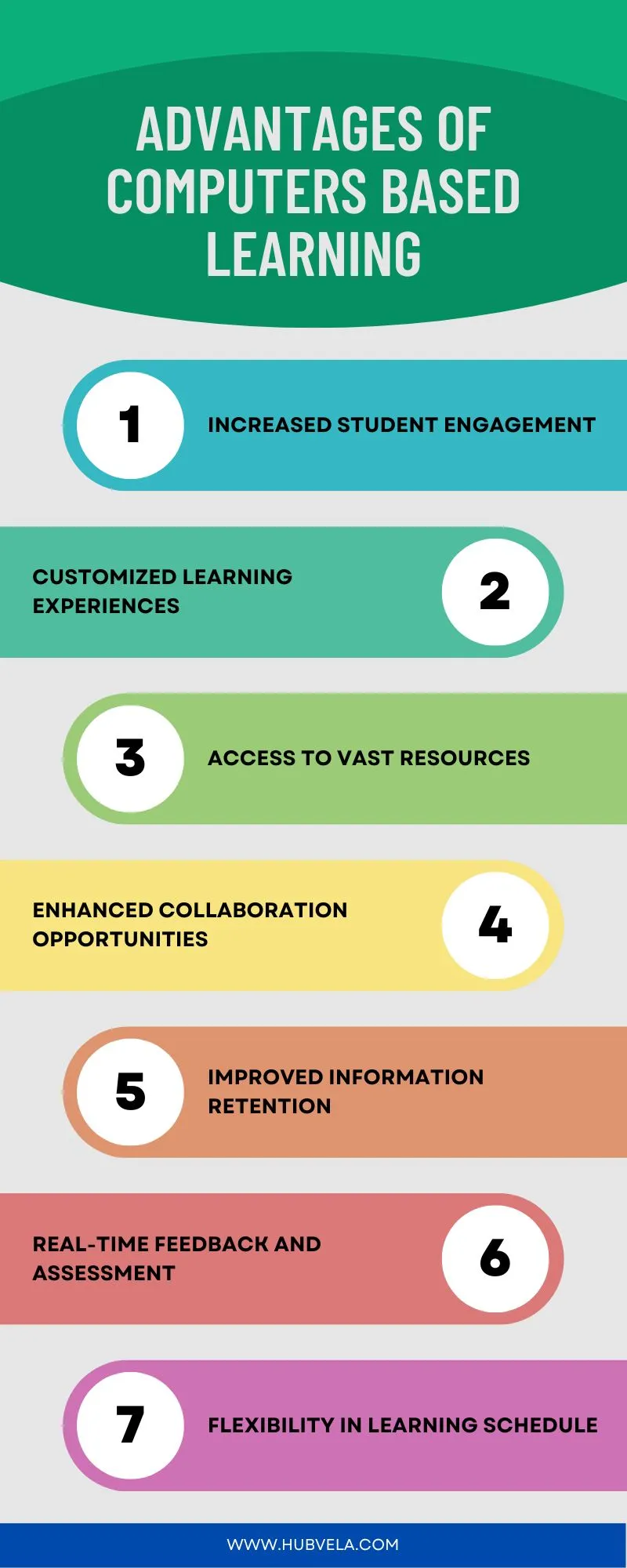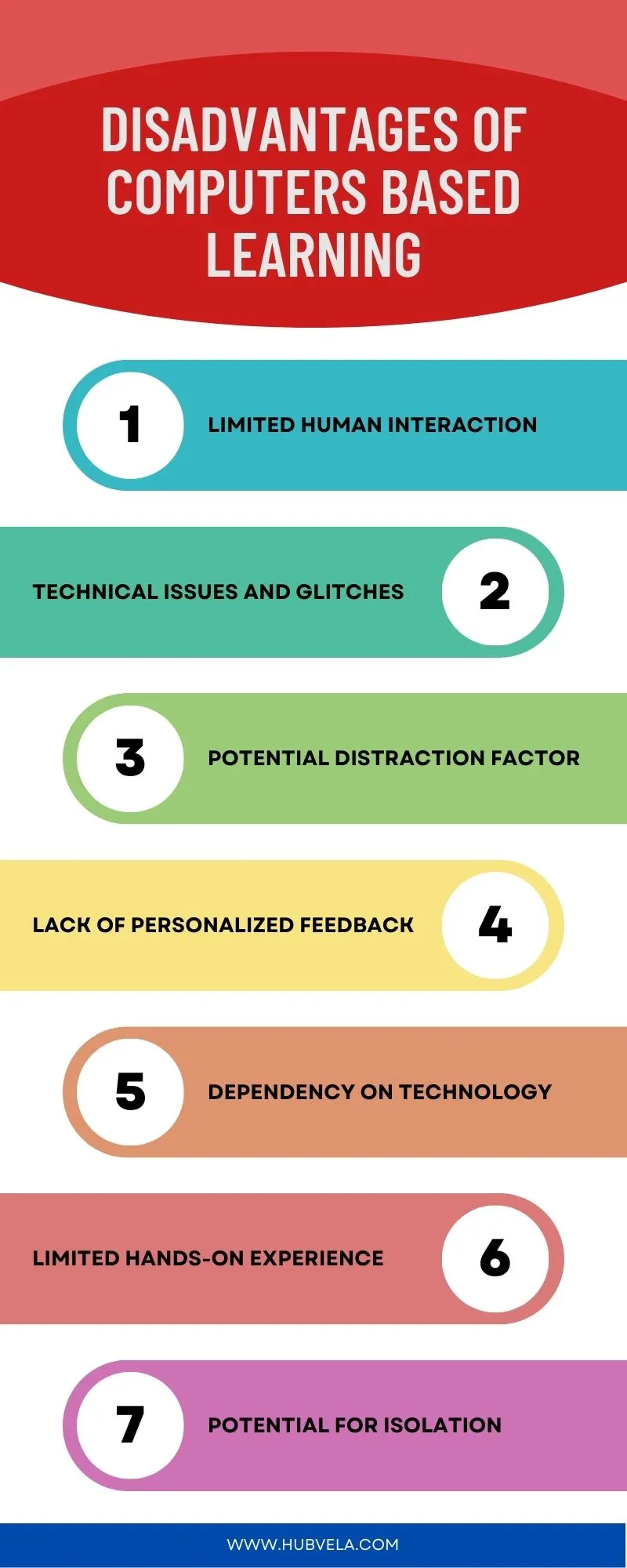Imagine a world where learning is just a click away. With computers-based learning, you have the power to explore a vast realm of knowledge and expand your horizons.
This method offers numerous advantages, such as increased engagement, customized learning experiences, and access to a plethora of resources. Collaboration becomes seamless, allowing you to connect and learn from others effortlessly.
However, like any tool, computers-based learning also has its disadvantages. You might become overly dependent on technology, limiting your hands-on experience. Additionally, there is a potential for isolation as face-to-face interactions decrease.
In this article, we will explore the advantages and disadvantages of computers based learning, enabling you to make informed decisions about your educational journey.

--Advertisement--
Advantages of Computers Based Learning
Computer-based learning, also known as computer-assisted learning, offers various advantages that have transformed the education and corporate training landscape.
This approach utilizes computers to deliver educational content, providing learners with greater control over their learning process and offering a wide range of benefits. Some of the key advantages of computer-based learning include:

1. Increased Student Engagement
Using computers for learning increases your engagement with the material and encourages active participation.
The interactive nature of computer-based learning can boost your motivation to learn, as it provides a more engaging and stimulating experience compared to traditional methods.
This increased motivation, in turn, can lead to improved academic performance.
With the use of computers, you can actively interact with the content, complete interactive exercises, and receive immediate feedback, enhancing your overall learning experience.
2. Customized Learning Experiences
Computers offer the advantage of providing you with customized learning experiences. With customized learning, you can receive individualized instruction that caters to your specific needs and learning style. This personalized approach allows you to learn at your own pace, focusing on areas where you need more practice or challenges.
3. Access to Vast Resources
With customized learning experiences, you gain access to vast resources that can enhance your learning journey.
Through online research, you can explore a wide range of information on any subject, expanding your knowledge beyond what’s covered in traditional classrooms.
Additionally, educational videos provide visual and interactive learning opportunities, making complex concepts easier to understand.
These resources allow you to delve deeper into topics of interest and learn at your own pace, fostering a more comprehensive understanding of the subject matter.
4. Enhanced Collaboration Opportunities
Collaborative opportunities are enhanced in computer-based learning, allowing you to actively engage with peers to deepen your understanding and exchange ideas.
With increased collaboration, you can work together on projects and assignments, leveraging different perspectives and skills.
Online platforms enable improved communication, facilitating real-time discussions, file sharing, and feedback.
Through interactive features such as discussion boards and virtual classrooms, you can connect with classmates from different locations, fostering a diverse and enriching learning environment.
5. Improved Information Retention
How can computer-based learning improve your information retention?
By engaging in computer-based learning, you can enhance your information processing abilities and cognitive development. Through interactive multimedia, simulations, and quizzes, computers offer a dynamic learning environment that promotes active engagement and deep understanding.
The visual and auditory stimuli provided by computer-based learning also aid in memory recall. Furthermore, immediate feedback and personalized learning experiences enable you to reinforce and consolidate your newfound knowledge, resulting in improved information retention.
6. Real-Time Feedback and Assessment
You will receive immediate feedback and assessment in real-time when engaging in computer-based learning.
This real-time assessment has numerous benefits, including the ability to identify areas of weakness or misunderstanding immediately.
With instant feedback, you can address any misconceptions or gaps in your understanding right away, allowing for quicker learning and improvement.
Additionally, real-time assessment allows for personalized learning experiences, as the computer can adapt the content and pace based on your performance.
7. Flexibility in Learning Schedule
One advantage of computer-based learning is that it offers you the flexibility to create your own schedule. With online classes and self-paced learning, you can decide when and where you want to study. This means that you can fit your learning around your other commitments and responsibilities.
Whether you prefer to study early in the morning or late at night, computer-based learning allows you to customize your learning schedule to suit your needs.
Disadvantages of Computers Based Learning
Computer-based learning (CBL) has become increasingly popular in recent years, offering numerous advantages such as flexibility, accessibility, and the ability to connect with learners across vast distances.
However, despite its many benefits, CBL also presents several disadvantages that cannot be overlooked. We will discuss the disadvantages of computer-based learning.

1. Limited Human Interaction
A major drawback of computer-based learning is that it limits your opportunities for human interaction. Interpersonal skills and social development are crucial in our personal and professional lives, and computer-based learning may not provide the same level of interaction as traditional classroom settings.
Building relationships, collaborating with peers, and engaging in discussions are all aspects of learning that can be hindered by the absence of human interaction in computer-based learning environments.
2. Technical Issues and Glitches
You may encounter technical issues and glitches when engaging in computer-based learning. These issues can include problems with software compatibility and the need for technical support.
When using different software programs or platforms for learning, there’s always a chance that they may not work well together. This can lead to frustrating technical glitches that hinder your learning experience.
It’s important to have access to reliable technical support to help troubleshoot and resolve any issues that may arise.
3. Potential Distraction Factor
One potential distraction factor of computer-based learning is the presence of numerous online distractions. With the internet at your fingertips, it’s easy to fall into the temptation of checking social media, browsing websites, or watching videos instead of focusing on your learning tasks.
Distraction management becomes crucial in this context. It’s important to develop strategies to minimize distractions, such as setting specific study times, using website blockers, or incorporating alternative learning methods that don’t rely heavily on computers.
4. Lack of Personalized Feedback
Managing distractions is just one challenge of computer-based learning; another drawback is the lack of personalized feedback.
Unlike traditional classrooms, where teachers can provide individualized guidance and support, computer-based learning often lacks this crucial element.
Without personalized feedback, students may struggle to understand their strengths and weaknesses, hindering their overall progress.
Although computers offer convenience and access to a wide range of educational materials, alternative educational methods that emphasize a personalized learning approach may be more effective in addressing this issue.
5. Dependency on Technology
A major disadvantage of computer-based learning is the dependency on technology. With this reliance, there’s a risk of technology becoming unavailable, leading to disruptions in the learning process.
Moreover, excessive use of computers for learning can have a negative impact on social skills. Interactions with peers and instructors in a traditional classroom setting foster communication and collaboration, whereas computer-based learning may limit face-to-face interactions, hindering the development of crucial social skills.
6. Limited Hands-On Experience
To fully understand the disadvantages of computer-based learning, it’s essential to examine the limited hands-on experience it provides.
One of the drawbacks of this type of learning is the lack of practical experience and hands-on learning opportunities. While computers can provide simulations and virtual experiences, they can’t fully replicate the real-world environment.
This limitation prevents learners from gaining the necessary skills and confidence that comes from physically engaging with the subject matter.
7. Potential for Isolation
One disadvantage of computer-based learning is its potential for isolating learners. Without the opportunity for social interaction with peers and teachers, learners may feel disconnected and lonely. This lack of human connection can have negative effects on their mental health, leading to feelings of anxiety and depression.
Additionally, the absence of face-to-face communication and collaboration can hinder the development of important social skills, such as teamwork and effective communication, which are crucial in the real world.
Conclusion on Advantages and Disadvantages of Computers Based Learning
The advantages and disadvantages of computer-based learning are worth considering. On the positive side, it offers flexibility, cost-effectiveness, and self-paced learning.
Learners can access materials from anywhere, reduce travel time, and work at their own pace. However, there are drawbacks, such as lack of human interaction, technical issues, and potential for distraction.
Despite its benefits, some may find it challenging to maintain motivation and engagement without the structure of traditional classroom learning.
In conclusion, while computer-based learning provides many benefits, it’s important to be aware of its limitations and potential impact on the learning experience.


